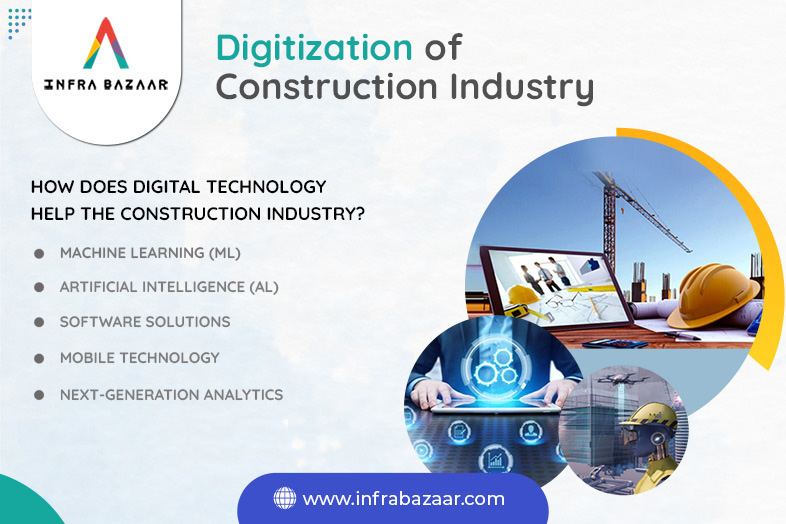
Posted By:Infra Bazaar
With the growth of digital technology, professionals from almost every industry are trying to make the most of it and make their jobs easier and efficient. If statistics are anything to go by, it is said that today 30-35% of construction companies report that they invest in technology to boost worker tasks and also many contractors believe that advanced technologies help with increased productivity and enhanced safety. These are reasons enough, that is promoting the digitalization of construction companies. It is also helping to take the construction to an all-new level in all forms of a construction project, right from architectural design to maintenance, and don’t forget the risk mitigation.
How Is The Construction Of A Building Carried Out?
Generally, we hire architects to work on designs with drafting or drawing tools and other aids and to define basic requirements. This has changed in a number of ways in the last few decades. The Architecture, Engineering, and Construction (AEC) industry began to see transformation through digitization, which started almost a decade ago. The transition from the drawings on paper and analogue processing into digital tools and computerized designs. The dynamic replicas of an asset that combines together the design, construction, and operational data is called the digital twin.
How Does Digitization Help?
In the Industry everyone has their own roles like the architect designs the models, the engineers make sure the integrity and rigidity of the structure are solid and robust, the contractors use BIM to understand clash detection and quantification but is this what the owner really wants?
At the end of the day, owners need a representation of physical/actual character building to help control the operations, which is now provided by digital tools. Many times, they also want to see their project objectives laid out in black and white, doing this digitally allows one to push that across the value chain. Digital twin technologies will make it very much easier for the architect, engineer, and builder to draw out expectations, define quality, thus ultimately meeting the needs of the owners.
What Is The Main Cause Of This Change?
The switch from paper to digital is certainly a response to global trends. Climate change, the increase in the extraction of materials used in construction, the waste generation has been causing serious problems. Apart from all of this labour shortage negatively impacting productivity is one of the key reasons for the origin of the change in the construction industry. Technology will help the construction industry to pursue large-scale projects while also focusing on environmental influence. Finding talent and professionals to fill good-level positions has become difficult which can be solved through technology, as the use of software, machines or robots means lowering demand for workers in the industry of construction.
One of the influencing factors of the transition to digital technology is urbanization requiring a higher demand for constructions not only of houses but also schools, hydraulic and power plants, etc, and technology allows this to be planned and executed in an easier and more accurate fashion.
How Does Digital Technology Help The Construction Industry?
MACHINE LEARNING (ML) AND ARTIFICIAL INTELLIGENCE (AI): Artificial intelligence and machine help in turning the collected data into accurate predictions and creating reports showing the amount of work that has been done, allowing contractors to gain an advantage.
SOFTWARE SOLUTIONS: Clash detection tools help in ensuring worker safety and so helps in preventing accidents, ensures transparency as it's recorded and streamed, helps in monitoring delivery times using GPS.
Mobile Technology: Help in monitoring the work from any location and without having to travel to remote locations saving travel time and expense. For instance, there are many apps that help with scheduling tasks, managing progress, and reporting results etc, like Co-Construct & Procore. Online purchasing & selling is another big industry in itself and has grown significantly. Platforms like INFRABAZAAR.COM and the like, help with machinery, construction material, equipment, leasing and so on. This is time-saving and offers great deals that your money thoughtfully.
Next-Generation Analytics: In today's world we have access to more information than ever. This information can help analyze time frame, costs, and plan for further or additional steps in a project with a considerably low risk of error. Having a foolproof execution plan provides insight into important problems and allows for adjustment to avoid them. Real-time analytics let contractors know whether or not preventive maintenance measures should be taken to extend the durability. Also, building analytics can help in improving the energy efficiency of houses, factories or office buildings.
How Is Digitalization Making A Difference?
A virtual view of the construction product and the processes involved can be obtained. All interested parties will have access to it and will be able to discuss any alternatives to find the best way to get the job done from the start to finish.
Digitisation of construction industries will bring benefits such as increment in safety levels, lower costs, higher profit margins, time efficiency, no travel, better collaboration and, of course, higher productivity.
#digitization #constructionindustry #artificialintelligence #machinelearning #software #mobiletechnology #nextgenanalytics #productivity #costefficiency #collaboration